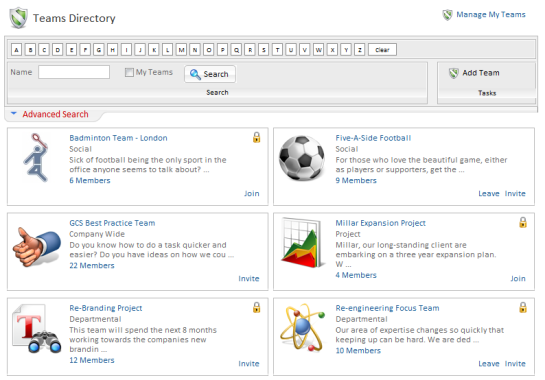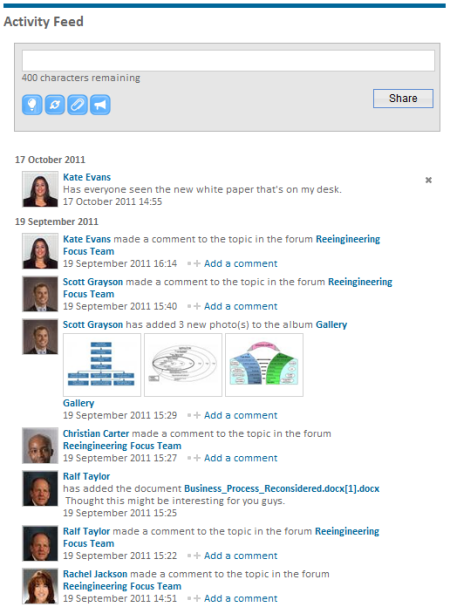Interact Teams – the smarter way to work together on your intranet
We recently hosted the highly successful Interaction 2011 intranet conference in London.
Preparing for this was a mammoth job, requiring people with unique skills from across the company. Marketing, sales, training, pre-sales, company IT, admin, client services and the finance departments were all involved. Several people who work predominantly out of the office were playing key roles, it was a daunting organisation challenge; but we had an ace up our sleeves.
We had the brilliant new Interact Teams module to help us.
This new module creates an environment within your intranet software that facilitates a much more effective team, project or committee working across companies, breaking down silos, making it easy for people to work together regardless of location, geographical location or time zone.
How does Interact Teams work?
Anyone can be given the permission to create a Team and take control of that Team area as a Team Owner, creating a great sense of ownership and increasing participation. There is, of course, an administrator permission for the module, so that overall control of all teams created can be maintained.
Creating the Team is very simple, the biggest choice being what sort of Team you want to create, there are three types:
Open – A Team anyone can search for and join without additional approval. For example a companywide ‘Best Practice’ team.
Private – A team that anyone can search for and request to join, with approval being given by the Team owner. These could be project teams, committees or company sports teams.
Hidden – This team can only be seen and searched for by those who are members. People can’t ask to join, they are invited to join, or simply added as members by the Team Owner. This higher level of discretion could be used for a company merger team or internal reorganisation team.
These different types mean that Teams can have a myriad of uses.
Once the new Team details have been selected, the really clever stuff happens. Interact takes the Team information and creates a team content area, automatically populating it, not only with Interact Intranet’s great collaboration features selected, like Blogs, Discussion Boards and Calendars, but also adding Team widgets to the Teams homepage to highlight these features.
New widgets are added automatically to the homepage that have been specifically created for teams, widgets that give information on the Team, it’s members and most importantly a brand new Teams Activity Feed widget.
This Activity Feed Widget is the collaborative centre of any Team and gives Team members an up-to-the-minute breakdown of documents, gallery images, blog posts, forum posts and calendar events added, as well as acting as a way of sending messages to the whole team.
Interact Intranet literally creates the Team area for the Team Owner. If the Team Owner wishes to add left hand navigation or adjust their Team homepage then this functionality is available. However, they could also simply start using the Team area immediately with no further action needed. Making Interact Teams so intuitive to use no additional training is required.
Guidance on the best use of the features offered and tips on how to get started is included within the structure of the new Team area providing everything a new Team Owner needs to get their team off to a great start.
What are the benefits?
As we discovered when using Interact Teams to help us plan Interaction 2011, just some of the benefits were improved communication, collaboration and knowledge sharing.
Member Control
By creating a ‘Private’ team the Team Owner could ensure that the team members required were included in the planning, without the need for overly structured face-to-face meeting time.
Everything in One Place
Using our Team area as a central repository area for the documents and resources needed meant it was far easier to find the information required both in the office and out of it. Documents such as guest speaker power point presentations. Adding documents through the Activity Feed made the process quick and easy, allowing us to concentrate on the planning of the event rather than the structure or organisation of the team.
Broadcast
The ‘Broadcast’ button on the Activity Feed means sending all team members important alerts of delevopments or advising them of approaching deadlines was a very simple two click process.
Blogging
We were able to use the Team blog to publish updates and make them public, so we could share progress with the whole company, keeping everybody updated with our progress.
Discussion
The Team Forums were invaluable. We discussed many subjects including award designs, room layouts, menu’s and poster designs,which meant that people who might not have been in the office or working during regular office hours could give the project the benefit of their experience and ideas.
View
The Image Gallery was a huge benefit to us as maps and hotel room plans were being heavily discussed. Pictures taken of the venue and the layout of the conference rooms were always at our finger tips to be commented on and referred back to.


